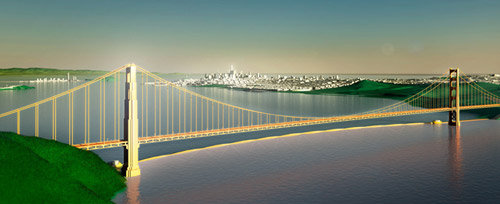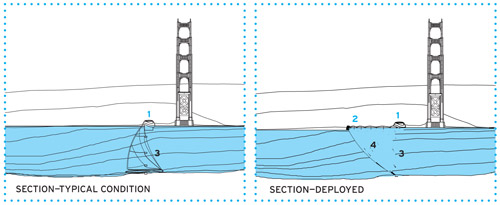Working with Water
Understanding risk
The population of coastal cities continues to grow. Now at 3 billion, the number of people worldwide living near the coasts is expected to nearly double by 2025. Many metropolitan areas are just beginning to consider the risks of sea-level rise. Miami is one of the most vulnerable cities in the U.S. with most of its neighborhoods and some $400 billion in assets lying around 3 feet above sea level. A storm surge from a Category 3 storm could submerge much of the city in 6 to 9 feet of water, according to the National Oceanic and Atmospheric Administration. Sea levels predicted for the end of the century would drive the coastline back dramatically, potentially flooding much of the city.
San Francisco is perhaps more fortunate than many coastal urban areas since its bay is relatively sheltered and the region has higher areas of retreat. But it also has many assets close to or below sea level. The Bay Conservation and Development Commission sponsored a competition called Rising Tides to consider ways to adapt to higher sea levels. One of six winning entries, the Skidmore, Owings & Merrill (SOM) BayArc scheme proposed an inflatable barrier placed at the bay's entry under the Golden Gate Bridge.
 |
ABOVE AND BELOW: Skidmore, Owings & Merrill has proposed a barrier to protect San Francisco Bay from periodic high water levels associated with sea-level rise. The device, which the firm calls BayArc, consists of a submerged, cable-reinforced membrane and an inflatable bladder. When deployed, the BayArc floats to the surface and creates a barrier stretching from the water's surface to the sea floor. 1 Tidal Energy Capture and Structural Anchorage Images: © Skidmore, Owings & Merrill, 2009. All Rights Reserved. U.S. Patent Pending |
 |
 |
"Our research showed that the problem would be in storm surges that occur at high tide," says Craig Hartman, design partner in SOM's San Francisco office. Add that swell to the projected sea-level rise, and many areas like the transportation corridor around San Francisco's airport could be threatened, he says.
The barrier "shaves off the tidal peak" during extreme events, says Hartman. The device has a 4-foot-high rigid band that acts like a dam at the water's surface. Below the surface, where the pressures are less, a web of tension cables hold a submerged curtain and the inflated barrier in place. Hartman relates that the deployable barrier doesn't address the long-term issue of substantial sea-level rise, but it could buy the area time to consider more comprehensive solutions.
Every coastal urban area has its own set of issues. The simple elegance of SOM's solution would have little application in New Orleans with the Mississippi River running through its heart, Lake Ponchartrain at its back, and the Gulf at its flank. But if the floodwaters of Katrina foreshadow things to come, then designers in coastal cities would do well to look at the proposals for the Gulf and the formidable challenges the region faces. On the Waggonner & Ball website there's a menu item that is fairly unusual in the profession: Research. The firm has extended its mission to engage universities, governmental agencies, and foreign countries in considering the task of saving one of America's most distinctive and culturally rich cities. Congress has ordered the Corps of Engineers to build New Orleans's levees to a 1:100 probability of flooding. Meanwhile the Dutch are building critical defenses to a 1:10,000 level. In his forward to the 2008 Delta Committee Report, chairman C.P. Veerman remarks that the document's proposals are unusual because they present an integrated plan to protect the Netherlands for centuries to come. "After all," he concludes, "a living land builds for the future."








